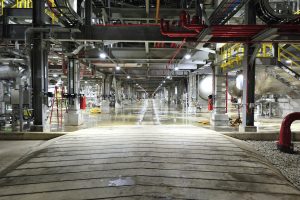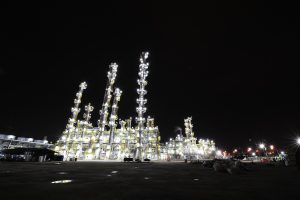Case Study: Lanxess
Singapore
LANXESS chooses Dialight LED lighting for new state-of-the-art facility in Jurong Island, Singapore.
LANXESS, a leading specialty chemicals company, announced the construction of a new butyl rubber plant in February 2008, to be located on Jurong Island, Singapore. Sitting on a 200,000 square metre plot of land, the new facility will process 100,000 tons per annum and LANXESS has allocated a record amount of EUR 400 million for this investment.
 Installation snapshot
Installation snapshot
- 200,000 sqm new facility
- 2,370 LED lighting fixtures for indoor/outdoor process areas and internal roads
- 55% energy reduction
- Annual power savings 1,150,000kWh / SGD 241,500
- 811 metric tonnes CO2 emissions avoided annually1
- ROI in 1.5 years for 24 hours operated fixtures
- ROI in 3 years for 12 hours operated fixtures
- Maintenance reduced
LANXESS carried out a complete evaluation of the existing process to manufacture butyl for the new Singapore facility and a radical redesign was implemented. The process, which draws on LANXESS long history of rubber expertise, will be best in class. A state-of-the-art power management and monitoring system will be installed.
The Challenge
LANXESS’s key objectives for the butyl plant are to be more energy and resource efficient, and also more environmentally friendly. The LANXESS project team recognised at the outset that the lighting solution would play an important role in achieving these objectives.
The challenge was to find suitable light fixtures that were certified for use in the hazardous environment, would deliver reliable lighting in normal and emergency mode operation, and would meet the requirements for reduced energy consumption and reduced maintenance.
In addition the lighting had to meet the Singapore Standard SS 531 which recommends lux levels for different areas within a facility, and the Green Mark requirements in SS 530 which define the power consumption per square metre that must be achieved in order to be considered energy efficient.
During the detailed engineering phase Johannes Goertz who is the LANXESS PCT Project Manager also highlighted their special requirements for emergency lighting. Dialight was able to modify the design of the LED lighting fixtures with built in battery backup to meet LANXESS requirements.
The Solution
The original design for the facility featured a mix of fluorescent T8s and metal halide fixtures, but in 2010 LANXESS gave Dialight the opportunity to propose a new lighting design featuring its LED lighting technology and the benefits immediately became apparent.
The Result
By converting to LED lighting, LANXESS saw its energy consumption and carbon emissions reduced by 55%. The low operating temperature of the LED fixtures was also a health and safety benefit, as it removed the risk of burn injury common with metal halides for anyone who might come into contact with the fixture.
In Singapore the Dialight LED benefit of built-in surge protection is also an important advantage during the rainy season from October to December. The region is prone to lightning strikes which can cause surges, resulting in the burnout of unprotected fluorescent ballasts and the consequential expense of maintenance.
LANXESS is a leading specialty chemicals company with sales of EUR 8.8 billion in 2011 and currently around 17,100 employees in 31 countries. The company is currently represented at 49 production sites worldwide. The core business of LANXESS is the development, manufacturing and marketing of plastics, rubber, intermediates and specialty chemicals. LANXESS is a member of the leading sustainable indices Dow Jones Sustainability Index (DJSI) World and FTSE4Good.
1Based on 7.0555 × 10-4 metric tons CO2 / kWh (www.epa.gov/cleanenergy)
Dialight reserves the right to make changes at any time in order to supply the best product possible.
